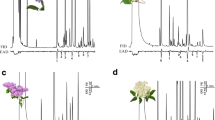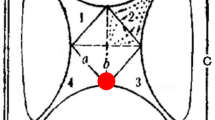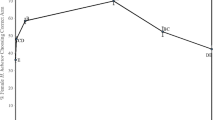Abstract
Codling moths are attracted to acetic acid and to ethyl-(E,Z)-2,4-decadienoate, the pear ester, when presented individually. The attraction to acetic acid is thought to be a food finding behavior, whereas the pear odorant, ethyl-(E,Z)-2,4-decadienoate, may be a host kairomone. We found, in a flight tunnel study, that more male and female codling moths were captured in traps when the compounds were presented together compared to tested separately. The combination of odorants provides a stronger lure for female codling moths than exists with pear ester alone and increases the potential for using lures in managing this pest of pome fruits and walnuts.
Similar content being viewed by others
References
Backmann, A. C., Bengtsson, M., Borg-Karlson, A. K., Liblikas, O., and Witzgall, P. 2001. Volatiles from apple (Malus domestica) eliciting antennal responses in female codling moth Cydia pomonella (L.) (Lepidoptera: Tortricidae): effect of plant injury and sampling technique. Z. Naturforsch. 56:262–268.
Bengtsson, M., Backmann, A. C., Liblikas, I., Ramirez, M. I., Borg Karlson, A. K., Ansebo, L., Anderson, P., Lofqvist, J., and Witzgall, P. 2001. Plant odor analysis of apple: antennal response of codling moth females to apple volatiles during phenological development. J. Agric. Food Chem. 49:3736–3741.
Brinton, F. E., Proverbs, M. D., and Carty, B. E. 1969. Artificial diet for mass production of the codling moth, Carpocapsa pomonella (Lepidoptera: Olethreutidae). Can. Entomol. 101:577–584.
Chen, J. L., Wu., J. W., Wang, Q., Deng, H., and Hu, X. S. 2006. Changes in the volatile compounds and chemical and physical properties of Kuerle fragrant pear (Pyrus serotina Reld) during storage. J. Agric. Food Chem. 54:842–847.
Clare, G., Suckling, D. M., Bradley, S. J., Walker, J. T. S., Shaw, P. W., Daly, J. M., Mclaren, G. F., and Wearing, C. H. 2000. Pheromone trap colour determines catch of non-target insects. J. Agric. Food Chem. 49:3736–3741.
Coracini, M., Bengtsson, M., Liblikas, L., and Witzgall, P. 2004. Attraction of codling moth males to apple volatiles. Entomol. Exp. Appl. 110:1–10.
Dethier, V. G. 1947. Chemical Insect Attractants and Repellents. Blakiston, Philadelphia.
Eyer, J. R. 1931. A four year study of codling moth baits in New Mexico. J. Econ. Entomol. 24:998–1001.
Hern, A. and Dorn, S. 1999. Sexual dimorphism in the orientation of adult Cydia pomonella in response to α-farnesene. Entomol. Exp. Appl. 92:63–72.
Hern, A. and Dorn, S. 2001. Statistical modeling of insect behavioral responses in relation to the chemical composition of test extracts. Physiol. Entomol. 26:381–390.
Hern, A. and Dorn, S. 2002. Induction of volatile emissions from ripening apple fruits infested with Cydia pomonella and the attraction of adult females. Entomol. Exp. Appl. 102:145–151.
Hern, A. and Dorn, S. 2004. A female-specific attractant for the codling moth, Cydia pomonella, from apple fruit volatiles. Naturwissenschaften 91:77–80.
Howell, J. F. 1981. Codling moth: the effect of adult diet on longevity, fecundity, fertility, and mating. J. Econ. Entomol. 74:13–18.
Il’ichev, A. L. 2004. First Australian trials of ethyl-(2E,4Z)-2,4-decadienoate for monitoring of female and male codling moth Cydia pomonella L. (Lepidoptera: Tortricidae) in pome fruit orchards. Gen. Appl. Entomol. 33:15–20.
Jennings, W. G., Creveling, R. K., and Heinz, D. E. 1964. Volatile esters of Bartlett pear. IV. Esters of trans:2-cis 4-decadienoic acid. J. Food Sci. 29:730–734.
Judd, G. J. R. and Gardiner, M. G. T. 2006. Temperature, irradiation and handling as factors affecting spring-time flight activity and recapture of mass-reared male codling moth, Cydia pomonella (L.), released by the Okanagan–Kootenay sterile insect programme. J. Entomol. Soc. B.C. 103:19–32.
Judd, G. J. R., Gardiner, M. G. T., Delury, N. C., and Karg, G. 2005. Reduced antennal sensitivity, behavioural response and attraction of male codling moths, Cydia pomonella (L.), to their pheromone (E, E)-8,10-dodecadien-1-ol following various pre-exposure regimes. Entomol. Exp. Appl. 114:65–78.
Knight, A. L. and Light, D. M. 2004. Use of ethyl (2E,4Z)-2,4-decadienoate in codling moth management: stimulation of oviposition. J. Entomol. Soc. B.C. 101:53–60.
Knight, A. L. and Light, D. M. 2005a. Seasonal flight patters of codling moth (Lepidoptera: Tortricidae) monitored with pear ester and codlemone-baited traps in sex pheromone treated apple orchards. Environ. Entomol. 34:1028–1035.
Knight, A. L. and Light, D. M. 2005b. Timing of egg hatch by early-season codling moth (Lepidoptera: Tortricidae) predicted by moth catch in pear ester- and codlemone-baited traps. Can. Entomol. 137:728–738.
Knight, A. L. and Light, D. M. 2005c. Factors affecting the differential capture of male and female codling moth (Lepidoptera: Tortricidae) in traps baited with ethyl-(E,Z)-2,4-decadienoate. Environ. Entomol. 34:1161–1169.
Knight, A. L., Vanbuskirk, P., Hilton, R. J., Zoller, B. G., and Light, D. M. 2002. Monitoring codling moth in four pear cultivars, with the pear ester. Acta Hortic. 584:215–220.
Kutinkova, H., Subchev, M., Light, S., and Lingren, B. 2005. Interactive effects of ethyl (2E,4Z)-2,4-decadienoate and sex pheromone lures to codling moth: apple orchard investigations in Bulgaria. J. Plant Prot. Res. 45:49–52.
Landolt, P. J. 1998. Chemical attractant for trapping yellowjackets Vespula germanica (Fab.) and Vespula pensylvanica (Saussure) (Hymenoptera: Vespidae). Environ. Entomol. 27:1229–1234.
Landolt, P. J. 2000. New chemical attractants for trapping Lacanobia subjuncta, Mamestra configurata, and Xestia c-nigrum (Lepidoptera: Noctuidae). J. Econ. Entomol. 93:101–106.
Landolt, P. J. and Alfaro, J. F. 2001. Trapping Lacanobia subjuncta, Xestia c-nigrum, and Mamestra configurata (Lepidoptera: Noctuidae) with acetic acid and 3-methyl-1-butanol in controlled release dispensers. Environ. Entomol. 30:656–667.
Landolt, P. J. and Guédot, C. 2008. Field attraction of codling moths (Lepidoptera: Tortricidae) to apple and pear fruit, with quantitation of kairomones from attractive ripe fruit. Ann. Entomol. Soc. Am. In press.
Light, D. M., Knight, A. L., Henrick, C. A., Rajapaska, D., Lingren, B., Dickens, J. C., Reynolds, K. M., Buttery, R. G., Merrill, G., Roitman, J., and Campbell, B. C. 2001. A pear derived kairomone with pheromonal potency that attracts male and female codling moth Cydia pomonella (L.). Naturwissenschaften 88:333–338.
Norris, M. J. 1936. The feeding habits of the adult Lepidoptera Heteroneura. Trans. R. Entomol. Soc. Lond. 85:61–90.
Reed, H. C. and Landolt, P. J. 2002. Attraction of mated female codling moths (Lepidoptera: Tortricidae) to apples and apple odor in a flight tunnel. Fla. Entomol. 85:324–329.
Shiota, H. 1990. Changes in the volatile composition of La France pear during maturation. J. Sci. Food Agric. 52:421–429.
Sutherland, O. R. W., Hutchins, R. F. N., and Wearing, C. H. 1974. The role of the hydrocarbon α-farnesene in the behavior of codling moth larvae and adults, pp. 249–263 in L. B. Browne (ed.). Experimental Analysis of Insect Behavior. Springer, Berlin, Germany.
Thwaite, W. G., Mooney, A. M., Eslick, M. A., and Nichol, H. I. 2004. Evaluating pear ester lures for monitoring Cydia pomonella (L.) (Lepidoptera: Tortricidae) in Granny Smith apples under mating disruption. Gen. Appl. Entomol. 33:55–60.
Trimble, R. M. and El-sayed, A. M. 2005. Potential of ethyl (2E,4Z)-2,4-decadienoate for monitoring activity of codling moth (Lepidoptera: Tortricidae) in eastern North American apple orchards. Can. Entomol. 137:110–116.
Utrio, P. and Eriksson, K. 1977. Volatile fermentation products as attractants for Macrolepidoptera. Ann. Zool. Fenn. 14:98–104.
Vallat, A. and Dorn, D. S. 2005. Changes in volatile emissions from apple trees and associated response of adult female codling moths over the fruit-growing season. J. Agric. Food Chem. 53:4083–4090.
Wearing, C. H., Connor, P. J., and Ambler, D K. D. 1973. Olfactory stimulation of oviposition and flight activity of the codling moth Laspeyresia pomonella, using apples in an automated olfactometer. N. Z. J. Sci. 16:697–710.
Yan, F., Bengtsson, M., and Witzgall, P. 1999. Behavioral response of female codling moths, Cydia pomonella, to apple volatiles. J. Chem. Ecol. 25:1343–1351.
Yothers, M. A. 1927. Summary of three years’ tests of trap baits for capturing the codling moth. J. Econ. Entomol. 20:567–575.
Zar, J. H. (1984) Biostatistical Analysis, Second Edition. Prentice Hall, Englewood Cliffs. 718 pp.
Acknowledgments
Technical assistance was provided by Daryl Green in Washington, USA; Vanessa Mitchell in New Zealand; and Mark Gardiner and Sarah Cockburn in British Columbia, Canada. This work was supported by grants from the Washington State Tree Fruit Research Commission and the New Zealand Foundation for Research Science and Technology, CO6X0301, Insecticide Risk Reduction.
Author information
Authors and Affiliations
Corresponding author
Rights and permissions
About this article
Cite this article
Landolt, P.J., Suckling, D.M. & Judd, G.J.R. Positive Interaction of a Feeding Attractant and a Host Kairomone for Trapping the Codling Moth, Cydia pomonella (L.). J Chem Ecol 33, 2236–2244 (2007). https://doi.org/10.1007/s10886-007-9391-1
Received:
Revised:
Accepted:
Published:
Issue Date:
DOI: https://doi.org/10.1007/s10886-007-9391-1




